
Oglethorpe University is a private college in Brookhaven, Georgia. It was chartered in 1835 and named in honor of General James Edward Oglethorpe, founder of the Colony of Georgia.

Fisk University is a private historically black liberal arts college in Nashville, Tennessee. It was founded in 1866 and its 40-acre (16 ha) campus is a historic district listed on the National Register of Historic Places.

The Cranbrook Educational Community is an education, research, and public museum complex in Bloomfield Hills, Michigan. This National Historic Landmark was founded in the early 20th century by newspaper mogul George Gough Booth. It consists of Cranbrook Schools, Cranbrook Academy of Art, Cranbrook Art Museum, Cranbrook Institute of Science, and Cranbrook House and Gardens. The founders also built Christ Church Cranbrook as a focal point in order to serve the educational complex. However, the church is a separate entity under the Episcopal Diocese of Michigan. The sprawling 319-acre (1,290,000 m2) campus began as a 174-acre (700,000 m2) farm, purchased in 1904. The organization takes its name from Cranbrook, England, the birthplace of the founder's father.

Hampton University is a private, historically black, research university in Hampton, Virginia. Founded in 1868 as Hampton Agricultural and Industrial School, it was established by Black and White leaders of the American Missionary Association after the American Civil War to provide education to freedmen. The campus houses the Hampton University Museum, which is the oldest museum of the African diaspora in the United States and the oldest museum in the commonwealth of Virginia. First led by former Union General Samuel Chapman Armstrong, Hampton University's main campus is located on 314 acres in Hampton, Virginia, on the banks of the Hampton River.

The Martin Luther King Jr. National Historical Park covers about 35 acres (0.14 km2) and includes several sites in Atlanta, Georgia related to the life and work of civil rights leader Martin Luther King Jr. Within the park is his boyhood home, and Ebenezer Baptist Church — the church where King was baptized and both he and his father, Martin Luther King Sr., were pastors — as well as, the grave site of King, Jr., and his wife, civil rights activist Coretta Scott King.
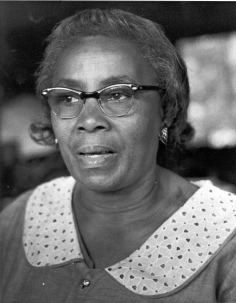
Septima Poinsette Clark was an African American educator and civil rights activist. Clark developed the literacy and citizenship workshops that played an important role in the drive for voting rights and civil rights for African Americans in the Civil Rights Movement. Septima Clark's work was commonly under-appreciated by Southern male activists. She became known as the "Queen mother" or "Grandmother" of the Civil Rights Movement in the United States. Martin Luther King Jr. commonly referred to Clark as "The Mother of the Movement". Clark's argument for her position in the Civil Rights Movement was one that claimed "knowledge could empower marginalized groups in ways that formal legal equality couldn't."

The Kentucky School for the Deaf (KSD), located in Danville, Kentucky, United States, is a school that provides education to deaf and hard-of-hearing children from elementary through high school levels. Founded in 1823, it was the first school for the deaf west of the Allegheny Mountains. Jacobs Hall, its oldest surviving building, was designated a National Historic Landmark in recognition of this history.
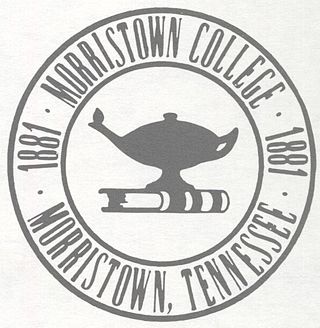
Morristown College was an African American higher education institution located in Morristown, the seat of Hamblen County, Tennessee. It was founded in 1881 by the national Freedman's Aid Society of the Methodist Episcopal Church. The school was renamed Knoxville College-Morristown Campus in 1989 and closed in 1994. Prior to the civil rights movement, the college held the distinction of being one of only two institutions in East Tennessee for African Americans, the other being Knoxville College, founded in 1875.

The Mary McLeod Bethune Home is a historic house on the campus of Bethune-Cookman University in Daytona Beach, Florida. Built in the early-1900s, it was home to Mary McLeod Bethune (1875-1955), a prominent African-American educator and civil rights leader, from 1913 until her death. It was designated a United States National Historic Landmark in 1974 It is now managed by the Mary McLeod Bethune Foundation as a historic house museum.

The Robert Russa Moton Museum is a historic site and museum in Farmville, Prince Edward County, Virginia. It is located in the former Robert Russa Moton High School, considered "the student birthplace of America's Civil Rights Movement" for its initial student strike and ultimate role in the 1954 Brown v. Board of Education case desegregating public schools. It was designated a National Historic Landmark in 1998, and is now a museum dedicated to that history. In 2022 it was designated an affiliated area of Brown v. Board of Education National Historical Park. The museum were named for African-American educator Robert Russa Moton.
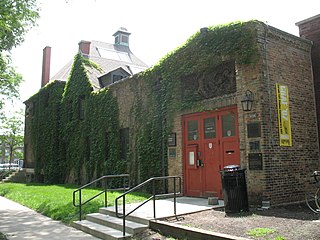
The Lorado Taft Midway Studios are a historic artist studio complex at South Ingleside Avenue and East 60th Street, on the campus of the University of Chicago on the South Side of Chicago. The architecturally haphazard structure, originating as two converted barns and a Victorian house, was used from 1906 to 1929 as the studio of Lorado Taft (1860-1936), one of the most influential sculptors of the period. A National Historic Landmark, it now houses the university's visual arts department.

The Savannah Historic District is a large urban U.S. historic district that roughly corresponds to the pre-civil war city limits of Savannah, Georgia. The area was declared a National Historic Landmark District in 1966, and is one of the largest urban, community-wide historic preservation districts in the United States. The district was made in recognition of the Oglethorpe Plan, a unique sort of urban planning begun by James Oglethorpe at the city's founding and propagated for the first century of its growth.

The Herndon Home is a historic house museum and National Historic Landmark at 587 University Place NW, in Atlanta, Georgia. An elegant Classical Revival mansion with Beaux Arts influences, it was the home of Alonzo Franklin Herndon (1858-1927), a rags-to-riches success story who was born into slavery, but went on to become Atlanta's first black millionaire as founder and head of the Atlanta Life Insurance Company. The house was designed by his wife Adrienne, and was almost entirely built with African-American labor. The house was declared a National Historic Landmark in 2000, and had previously been declared a "landmark building exterior" by the city of Atlanta in 1989.
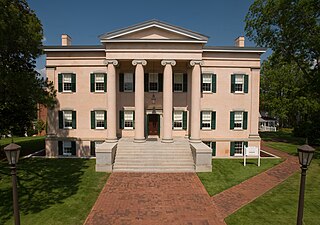
Georgia's Old Governor's Mansion is a historic house museum located on the campus of Georgia College & State University (GCSU) at 120 South Clarke Street in Milledgeville, Georgia. Built in 1839, it is one of the finest examples of Greek Revival architecture in the American South, and was designated a National Historic Landmark for its architecture in 1973. It served as Georgia's executive mansion from 1839- 1868, and has from 1889 been a university property, serving for a time as its official president's residence. It is an accredited museum of the American Alliance of Museums and in 2015 was named an affiliate of the Smithsonian Institution.

Fountain Hall, formerly Fairchild Hall and Stone Hall, is a historic academic building on the grounds of Morris Brown College in Atlanta, Georgia. Built in 1882, it is the oldest surviving building originally associated with Atlanta University - now Clark Atlanta University - which is the first of all historically black colleges and universities in the American South founded September 19, 1865. It was declared a National Historic Landmark in 1974. It is now named after Bishop William A. Fountain.

Augusta, Georgia was founded in 1736 as part of the British colony of Georgia, under the supervision of colony founder James Oglethorpe. It was the colony's second established town, after Savannah. Today, Augusta is the third-largest city in Georgia, and the largest city of the Central Savannah River Area.
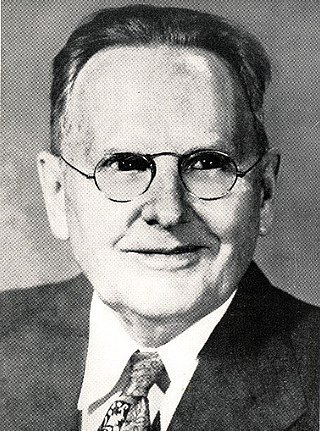
George Awsumb was a prominent Norwegian-American architect in the first half of the 20th century. Awsumb defined architecture as “frozen music” designed for the “man on the street.” He was influenced by his early life, European travels, and prevailing architectural trends of his time. His eclectic, progressive portfolio included neoclassical, Gothic Revival, Prairie School, and International Style designs. Several buildings that Awsumb designed have been in continuous use in the American Midwest and South for over 100 years. In particular, Awsumb began a family architectural legacy that contributed to the progress and development of Memphis, Tennessee.

Columbus Public Health is the health department of Columbus, Ohio. The department is accredited by the Public Health Accreditation Board. The department dates to 1833, when the city's mayor appointed five citizens to help with its cholera outbreak. It became a permanent body to activate whenever health emergencies arose.


























